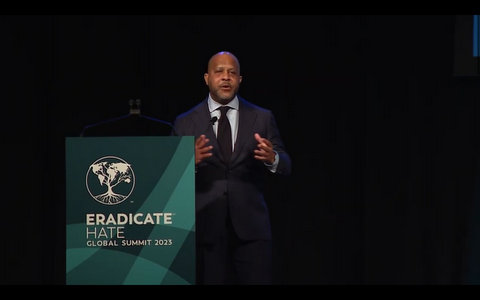
02 Oct Immigration Misinformation Targets Decisive U.S. Latino Vote

(Photo via EMS)
By Selen Ozturk, Ethnic Media Services
If not countered, misinformation targeting immigrants and Latinos will be make-or-break this election year.
Although the political use of immigration as a scapegoat for hate is nothing new, the Latino vote — the largest-growing U.S. voter demographic, with currently 36.2 million Latinos representing 15% of all eligible voters — able to decide elections in large states like California, Texas and Florida, and swing states like Nevada, Arizona, Georgia, Wisconsin and North Carolina.
At a Thursday, Sept. 26 panel held by CALÓ News and the Latino Media Collaborative, ethnic media leaders explained the trending misinformation tactics used to undermine electoral trust among Latinos, and discussed ways to fight this misinformation.
‘Undermining the voice of a decisive vote’
“Millions of immigrants are living quietly in harmony with native-born residents. We’re neighbors, co-workers and friends, and we’re caring for each other across racial, ethnic and bipartisan lines — yet we rarely see those stories on the front page,” said Jessica González, co-CEO of Free Press.
“Instead, we see stories that exploit and demonize immigrants. We see the lie that non-citizen immigrants are voting in droves, fabrications about Haitian immigrants, false claims such as that the U.S. election will be extended this year,” she continued. “The intent is to scare voters of color from the polls, to pander to anti-immigrant sentiment by stirring up fear … and to legitimize authoritarian power-grabs by sowing distrust in our electoral process.”
A 2024 Free Press poll of 3,000 Americans found that 79% were “concerned that the information they see online is fake, false or a deliberate attempt to confuse people,” while 76% were concerned about 2024 presidential election misinformation.
>>>Read:
Political News Is in Its ‘Double-Checking Era’<<<
“I became politically active organizing 10,000 students to march out of LAUSD schools during the ’90s in California’s Prop 187 era,” said Jennie Carreón, principal of public affairs firm Carreón Group. “It’s hard to believe that it passed. It denied undocumented immigrants access to public education and social services, and it also required police to report and verify the immigration status of all individuals.”
“Thankfully, Prop 187 was struck down by the courts, but 30 years later, here we are hearing the same anti-immigration stories, but this time it’s at a national level,” she added. “Latino voter misinformation is undermining the voice of a decisive vote in 2024 … and we need to show its impact in a digestible way, so that a generation of new voters doesn’t feel so apprehensive.”
Trending misinformation
“These messages with the purpose of creating hate and fear are no longer just about undocumented immigrants. We’re now seeing attacks on legal immigrants — such as DACA and other legal pathway programs, and recently the Springfield, Ohio, Haitian community, most of whom had Temporary Protected Status,” said Vanessa Cárdenas, executive director of America’s Voice.
In tracking media coverage of immigration reform, America’s Voice found two common ideas behind these attacks, she explained, the first being a “replacement theory … that immigrants are here to replace ‘real’ Americans and ineligible immigrants are going to vote in our election, seeding doubt as to whether we can trust the outcome.”
State-led investigations by Republican and Democratic officials, news organizations, law enforcement and universities have found that noncitizen voting is extraordinarily rare.
For instance, a 2016 Brennan Center survey of 44 election administrators overseeing 23.5 million votes across 42 states saw 30 incidents of suspected noncitizen voting — or .0001% of all votes.
A state-led audit of 1.1 million ballots in Nevada that same year identified three noncitizens who had voted, amounting to .0003% of all votes.
A 2020 state investigation in Ohio referred 104 cases of alleged noncitizen voter registration and 13 cases of alleged noncitizen voting for prosecution; because the latter would amount to .00016% of all votes, Ohio’s own secretary of state said “voter fraud is exceedingly rare.”
The second idea behind trending misinformation “pits Latinos who’ve been in the U.S. for generations against new migrants … through a notion of scarcity, crime and racial tensions, particularly in communities in blue cities, like New York, where migrants were sent from Texas,” Cárdenas explained. “These narratives are setting the stage for the idea that it is okay to deport people en masse because these folks are not desirable, not American.”
Economists estimate that a mass deportation of undocumented immigrants, of the kind proposed by Donald Trump’s 2024 presidential campaign, would entail economic losses between $711 billion and $1.7 trillion, at 2023 levels.
Given a removal of 11 million people, this would entail a shrinking of the U.S. economy between 2.6% and 6%.
“The reason why so many undocumented immigrants are coming to the U.S. is because the U.S. has destabilized their economy and governments,” added Anshantia Oso, senior director of Black history project Media 2070. “U.S. foreign policy is a pull factor for immigrants to come to the U.S., and our political candidates are manipulating ideas of scarcity to keep the population scared and divided.”
Fighting misinformation
“In having conversation with folks who may be repeating this misinformation, it’s important to understand what their concerns actually are,” Oso continued. “Often, political rhetoric plays on valid concerns around housing, jobs or finances … and it’s not about being anti-immigrant, but having a government that’s actually going to work for us. We need to speak to those concerns and point towards actual solutions.”
A demographically representative Harvard Kennedy School poll found that 49% of Americans were exposed to some form of misinformation intervention, like social media fact-checking.
However, these interventions triggered significantly polarized responses between Democrats, who supported the intervention overall, and Republicans, who opposed content evaluation on the grounds that it was biased.
“One approach to countering disinformation is not getting bogged down in tackling specific claims, but rather exposing their motives of division,” said Roberta Braga, founder and executive director of Digital Democracy Institute of the Americas (DDIA).
“We don’t have to correct the record on every single thing we see. Instead, we should focus on changing the conversation by telling real stories about the impact of deportation policies,” she continued, “and by telling stories about what a functional migration system would look like by telling immigrant success stories.”
“The issue is that fighting misinformation doesn’t work the same way for everyone,” said Braga. “Someone who believes one in 15 lies may need a fact check, but someone who believes 14 out of 15 lies, that’s not what they’ll respond to. Beyond content-oriented factors, we need to consider the real day-to-day concerns that people have.”
A June 2024 DDIA poll found that most Latinos targeted by misinformation don’t outright believe it. Among the 3,000 Latino adults polled, 62% were either unsure of, or rejected, media misinformation claims.
Although the DDIA findings, like the Harvard Kennedy School poll, saw consistent correlation of Republican party affiliation with “lower levels of trust and confidence that one’s vote will count,” low trust in the system wasn’t correlated with voter turnout for Latinos.
In other words, many Latinos less likely to perceive their vote to matter would still vote despite this ambivalence.
“There’s a large group of Latino voters out there that are undecided or ambivalent, and I think that’s where we should be spending most of our time sharing our information and ideas,” Cárdenas said. “These are people that we could really move to our side.”






No Comments